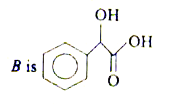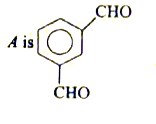The Hinsberg's test of a compound, C5H14N2 produces a solid that is insoluble in 10% aq. NaOH. This solid derivative dissolves in 10% aqueous sulphuric acid. Which of the following would best describe these facts?
NH2CH2CH2N(CH3)2
(CH3)2NCH2CH2NHCH3
NH2CH2C(CH3)2CH2NH2
(CH3)2NCH2N(CH3)2
To solve the problem regarding the compound C5H14N2 and its behavior in Hinsberg's test, we can follow these steps:
Step 1: Understand the Hinsberg's Test
Hinsberg's test is used to differentiate between primary, secondary, and tertiary amines. The test involves the reaction of amines with benzene sulfonyl chloride, which leads to the formation of sulfonamides.
Step 2: Analyze the Given Compound
The molecular formula C5H14N2 indicates that the compound contains two nitrogen atoms. This suggests that it could be either a primary amine, a secondary amine, or a combination of both.
Step 3: Predict the Reaction Outcomes
1. Primary Amines: React with benzene sulfonyl chloride to form a sulfonamide that is soluble in 10% NaOH.
2. Secondary Amines: React with benzene sulfonyl chloride to form a sulfonamide that is insoluble in 10% NaOH.
3. Tertiary Amines: Do not react with benzene sulfonyl chloride and therefore do not form any sulfonamide.
Step 4: Evaluate the Observations
The problem states that the solid produced is insoluble in 10% aqueous NaOH. This indicates that the compound is likely a secondary amine, as secondary amines produce sulfonamides that are insoluble in NaOH.
Step 5: Further Solubility Testing
The solid derivative dissolves in 10% aqueous sulfuric acid. This behavior is consistent with sulfonamides formed from secondary amines, as they can react with acids to form soluble salts.
Conclusion
Based on the observations from the Hinsberg's test, the compound C5H14N2 is best described as a secondary amine.
Final Answer
The best description of the facts given in the question is that the compound is a secondary amine.
---
Hinsberg's test is used to differentiate between primary, secondary, and tertiary amines. The test involves the reaction of amines with benzene sulfonyl chloride, which leads to the formation of sulfonamides.
The molecular formula C5H14N2 indicates that the compound contains two nitrogen atoms. This suggests that it could be either a primary amine, a secondary amine, or a combination of both.
1. Primary Amines: React with benzene sulfonyl chloride to form a sulfonamide that is soluble in 10% NaOH.
2. Secondary Amines: React with benzene sulfonyl chloride to form a sulfonamide that is insoluble in 10% NaOH.
3. Tertiary Amines: Do not react with benzene sulfonyl chloride and therefore do not form any sulfonamide.
The problem states that the solid produced is insoluble in 10% aqueous NaOH. This indicates that the compound is likely a secondary amine, as secondary amines produce sulfonamides that are insoluble in NaOH.
The solid derivative dissolves in 10% aqueous sulfuric acid. This behavior is consistent with sulfonamides formed from secondary amines, as they can react with acids to form soluble salts.
Based on the observations from the Hinsberg's test, the compound C5H14N2 is best described as a secondary amine.
The best description of the facts given in the question is that the compound is a secondary amine.
Topper's Solved these Questions
- AMINES BOOK - NCERT FINGERTPS ENGLISHCHAPTER - AMINES EXERCISE - Classification
2 Videos
- AMINES BOOK - NCERT FINGERTPS ENGLISHCHAPTER - AMINES EXERCISE - Preparation Of Amines
5 Videos
- ALDEHYDES, KETONES AND CARBOXYLIC ACIDSBOOK - NCERT FINGERTPS ENGLISHCHAPTER - ALDEHYDES, KETONES AND CARBOXYLIC ACIDSEXERCISE - Assertion And Reason
15 Videos
- BIOMOLECULESBOOK - NCERT FINGERTPS ENGLISHCHAPTER - BIOMOLECULESEXERCISE - Assertion And Reason
15 Videos
Similar Questions
Compounds P(C6H10) does not have any geometrical isomer.On ozonolysis, two products R(C3H4O) and Q(C3H6O) are formed.R gives negative iodoform test while Q responds positively towards I2/NaOH solution.S, another isomer of P is an unsymetrical alkene and on ozonolysis produces T(C6H107) which also gives a yellow precipitate with l2/NaOH solution and also positive test with Tollen's reagent Which of the following does not represent any of the molecules amongst P,Q,R,S & T.
View SolutionWhite crystalline solid (A) reacts with H2 to form a highly associated liquid (B) and a monoatomic , colourless gas (C ). The liquid (B) is used for etching glass. Compound (A) undergoes hydrolysis slowly to form (C ), (B) and a diatomic gas (D ) whose IE is almost similar to that of (C ). (B) forms an addition compound with KF to form (E) which is electrolysed in the molten state to form a most reactive gas (F) which combines with (C ) in 2:1 ratio of produce (A).
Which of the following is correct for the white crystalline solid (A) ?
View Solution
Knowledge Check
A C8H10 hydrocarbon is nitrated by HNO3 and sulphuric acid. Two, and only two, C8H9NO2 isomers are obtained. Which of the following fits this evidence ?
Aethyl benzeneBortho-xyleneCmeta-xyleneDpara-xyleneCompound (A) C8H6O2 on treatment with aq. NaOH followed by acidification gives (B) C3H2O3 which on oxidation gives benzoic acid only:
A B
B C
C D
D
Solid KCl, when heated with solid K2Cr2O7 and concentrated H2SO4, gives red vapours (a) that turn NaOH solution yellow (b). The yellow solution, when acidified with acetic acid and treated with lead acetate, gives a yellow precipitate (c). which of the following is true with respect to a, b and c?
View SolutionA compound (X) with molecular formula C3H9N reacts with C6H5SO2Cl to give a solid which is insoluble in alkali. (X) is
View SolutionA compound Z with molecular formula C3H9N reacts with C6H5SO2Cl to give a solid, insoluble in alkali. Identify Z.
View SolutionA compound Z with molecular formula C3H9N reacts with C6H5SO2Cl to give a solid, insoluble in alkali. Identify Z.
View SolutionA compound Z with molecular formula C3H9N reacts with C6H5SO2Cl to give a solid, insoluble in alkali. Identify Z.
View SolutionAn organic compound (A) (C8H8O3) was insoluble in water, dilute HCI, and NaHCO3. It was soluble in NaOH. A solution of (A) in dilute NaOH was boiled and steam distilled and distillate was reacted with NaOH to give a yellow precipitate. The alkaline residue is acidifield to give a solid (B) (C7H6O3). (B) dissolves in aqueous NaHCO3 with the evolution of gas. Identify (A) and (B).
View Solution
